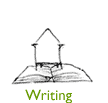Architecture : research
(see also pouf! art + architecture)
Since 2002, I have taught at several Canadian Universities in Departments of Art History and Schools of Architecture. Presently I am Associate Professor of Architectural History in the Department of Art History at Concordia University, Montréal.
Gender:
My interest in the productive relationships between users, particularly women, and the built environment informs my work on architecture, cities, landscapes, and art. Working against the deeply entrenched idea that space is passive, my projects explore the built environment as an agent that inspires humans (as well as non-human subjects) to act, whether this act takes the form of a walk, an art project, or the creation of a building or city plan. My approach is always mindful of the ways in which normalizing ideas about gender are built into and negotiated within the designed environment. I am also very interested in the rich history of how women have created space – through the design of buildings, landscapes, and cities – but also through the creation of cultural and social space. Many of my publications (see Writing) reflect these concerns, as do my work with graduate students in Art History and interdisciplinary programs at Concordia.
Space/site:
My belief as a researcher, practitioner, and teacher is that all spatial environments and spatial practices can be better understood through their histories of design and use. Whether researching the history of a dog park in present-day Griffintown, the use of pavilion hospitals in colonial expansion, or “3-D graffiti” in post-socialist cities I seek, through architectural and social history, to better understand the contexts that precede the moment in which I discover a particular place or building. Learning about those contexts helps me to illuminate the ways in which a place comes to look the way it does, over time, and sheds light on the political or economic issues that manifest in a given place. There is no better way to understanding space as a site – a location that is historically, culturally, and economically specific – than to begin research on site, to see for oneself the visual, spatial, and material qualities that have made that place what it is. Students working with me in the past have explored these ideas through a number of online publications about Montreal’s built environment, via the website, Montreal as Palimpsest/Montréal comme palimpseste.
Interdisciplinarity:
I came to study architecture as an outsider: someone who trained as a visual artist, then as an art historian, and then as someone who engages in interdisciplinary practice, bringing art-making, architectural history, and spatial analysis together with archival research. This approach still informs my work, such as my first solo-authored book, Architects, Angels, Activists and the City of Bath, 1765-1965 (Ashgate 2012), and my ongoing work with Thomas Strickland in our art/design firm, pouf! art + architecture. My perspective on interdisciplinarity and research-creation is that these modes of inquiry offer creative and powerful platforms on which to communicate research concerns and findings in innovative ways. These platforms are always more rigorously and effectively mobilized if archival and primary research are a fundamental part of the process. That way, the relationships between creative production and scholarly inquiry are mutually constitutive, from the outset.
Inspiration:
Many feminist thinkers have inspired my approach to research, art, and teaching. I owe a particular debt to Elizabeth Grosz, Donna Haraway, Annmarie Adams, Janice Helland, Dolores Hayden, Lynne Walker, Gwendolyn Wright, Kathleen Bristol, Joan Acland, Rosi Braidotti, Judith Butler, Moira Gatens, and for her acutely beautiful compassion for others, Tove Jansson.





